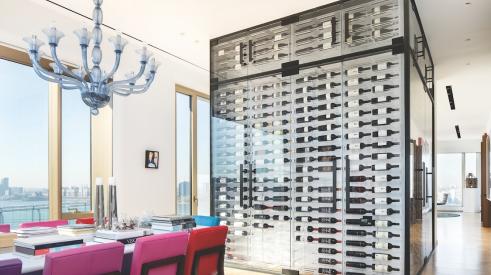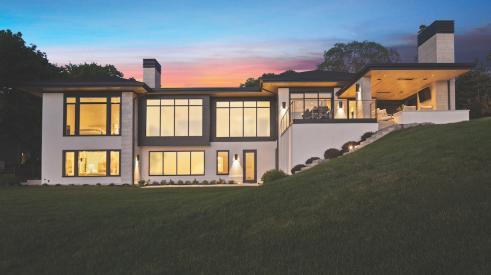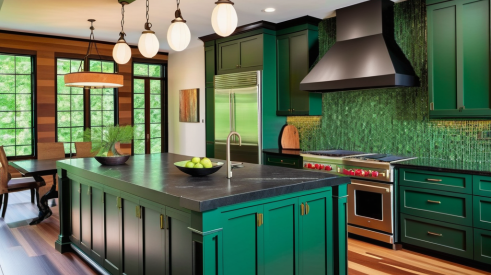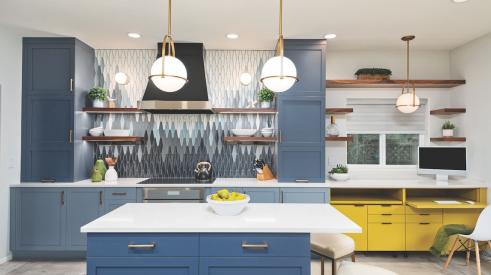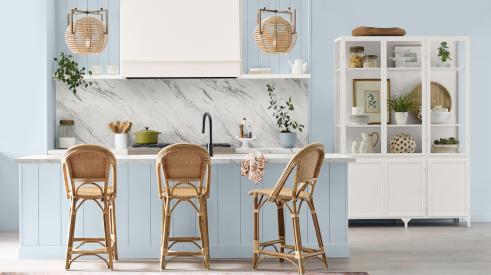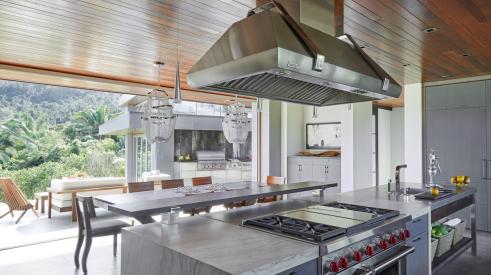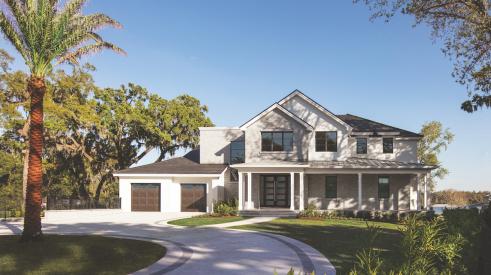|
Rampart brightened the front with new windows, French doors, fiber-cement siding and a brick terrace. Rampart restored these antique front doors with new leaded glass and hardware, inserted new pieces into the door panels and jambs to enlarge the narrow doors, and built matching sidelights. Photos by Bob Thompson
Roofing: MonierLifetile. Siding: James Hardie. Windows: Weather Shield. |
||||||||||||||
|
The old pool enclosure trapped the house behind a wall of dull screening. Rampart crushed in the old swimming pool and built the tropical room on the site, then built a new pool and screened enclosure on the side. The tropical room opens the great room and bedroom wing to light and views. When the columns arrived, Corcoran worried that they would look too skimpy. King solved the problem by beefing them up with furring strips, wire lath and stucco.
|
||||||||||||||
|
The white cabinetry and finishes of the enlarged kitchen blend cleanly with the open-plan living spaces. A two-sided fireplace at the side of the living room can also be enjoyed from the kitchen, and replaces a large, stone living room fireplace that confined the front entry. Counters: Cambria. Faucet: Kohler. Fireplace: Heatilator
|
||||||||||||||
|
||||||||||||||
John and Sally Corcoran were eager to get rolling on their ranch house remodel in Sarasota, Fla., but their contractor, John King, CGR, knew better than to hit the gas pedal too quickly. His company, Rampart Homes, has an AAA-style philosophy of remodeling: To avoid problems, plan the trip before pulling out of the driveway.
Rampart Homes creates the road map with an exhaustive feasibility study that looks at the cost of moving versus remodeling versus tearing down and building new. Rampart investigates zoning requirements, homeowner association restrictions, flood-plain regulations and other site restrictions. After completing this study, Rampart signs a design analysis agreement with the client, which includes a scope of work and specifications with conceptual budget; meeting with subcontractors and structural and environmental engineers; preparing a product selection manual; and finalizing working drawings.
"They virtually build your house on paper," says Sally Corcoran. "I was very impressed."
The Corcorans purchased their 21-year-old, 5,900-square-foot house and the 7-acre property surrounding it in 2001. As built, the narrow, crescent-shaped home had a central entry and living room. Long hallways provided cross-ventilation and access to rooms along the wings. After two years, they were ready for a remodel and had an architect draw plans featuring a larger master suite, a new pool and tropical room, a wider bedroom hallway, a new entry and entry foyer, and an open living room. French doors and bigger windows would both transform the exterior and brighten up the interior.
Per company policy, King and David Dunworth, Rampart's operations vice president, held the first meeting in their office on Jan. 21, 2003. "This also gives us a chance to see who they
really are," says Dunworth. "We get to educate the clients about remodeling - square foot costs versus reality, cost differences between new construction and tying in everything existing, etc."
Rather than give an off-the-cuff, potentially misleading estimate, King explained Rampart's practice of developing a detailed set of specs that becomes the basis for an accurate contract price. He showed them the centerpiece of the system, a 25-page product selection guide with names, locations and contact information for each of Rampart's preferred vendors, and the specs required for each product category. The Corcorans also saw examples of the job books - neatly organized with dividers for contract, scope of work, schedule, notes and more.
During the meeting, it quickly became apparent to the Corcorans that the architect's plans had not been thorough. Without a demolition or an existing electrical or plumbing plan, the Corcorans didn't understand fully if the remodeled house would fulfill their needs. Gray areas such as truss layout had not been addressed and the clients didn't know whether a security system, gutters and other features were part of the scope of work.
"We never accept money at the initial meeting," says Dunworth. "Potential clients must take the time to fully evaluate all we have shared with them prior to signing an agreement." The Corcorans did just that. A few days later they signed off on a feasibility study and design analysis.
Remodeling the design
With plans already drawn, Rampart only needed to do an abbreviated feasibility study. King and Dunworth went out for a first look at the house. At this and subsequent site visits, they took digital photos, eventually amassing about 150 date-stamped photos of every detail of the house, which they used for reference during the estimating and design - and which constituted a record of conditions in case disagreements arose later.
Finding no major structural or site constraints, Rampart quickly entered the design phase, modifying the architect's plans to meet the Corcoran's budget. The planning process involved numerous meetings and eight revisions of the design, selections and specifications over a four-month period to arrive at a detailed, priced-out plan and construction drawings.
When design analysis began, King held an initial trades meeting at the Corcoran house so the trade contractors could assess its site and as-built condition. Rampart uses all subcontractors and has a stable of regular trade partners who "know our quality of work and our rules about behavior on the job, who communicate well with us and care about the job." With their input on the scope of work, "we continue to build the specs," says King. "Next we come back with modified plans" and use those to get an accurate proposal from the subs who contributed input.
With the help of King and the suppliers, Corcoran worked her way through the product selection guide. After she chose a window manufacturer and style, for example, the window vendor helped her to select finishes, sill types and sizes, then gave both her and Rampart a copy of the proposal for the selection guide.
Breaking the rules
Rampart's selection process includes a "Big Six" review of the scope of work - a cost breakdown of six or more items that can be modified or eliminated if the client wants to bring the quote down. When the $637,000 job price came in, "I felt it was a pretty close estimate," recalls Corcoran. Nevertheless, it exceeded her budget. To save money, she eliminated a few features from the remodeling plan.
In addition, King strayed from Rampart's process by letting Corcoran contract directly with a pool company. Her contractor dug the hole months before the pool was set, then ran into problems with the sloping site. King said an engineering assessment and retaining wall were in order. After initial resistance and many discussions, the pool company agreed, building a retaining wall and selecting a better location for the pool equipment. The cost: King's project management time.
King bent another rule by going along with Corcoran's decision to use a custom cabinet company that had never worked with Rampart. The cabinet company had to provide Rampart with proof of license, incorporation, liability and workers' compensation insurance. A conflict in planning systems, however, became an issue. "We normally request the cabinet company draw the cabinet layout on the kitchen floor" with a marker, says King, so that Rampart can precisely plan the location for electrical connections and so on. "Then we're building to fit the cabinets versus fitting the cabinets to what we build," he says. Instead, the cabinet company sketched the cabinet locations with hard-to-read pencil, and drew the stove and microwave in the wrong place. Nobody caught the error until the cabinets arrived. "We had to relocate the venting for the microwave and stove," says King. The cabinet company readily covered the cost.
A third detour from the plan involved the roof. Though Rampart wants clients to make all selections before signing the construction contract, travel and indecision somewhat delayed the Corcorans. Sally Corcoran had not settled on a specific roofing product when work began, but she had at least decided to use shingles. Because the construction contract included an allowance for shingles, the roof was prepared for shingles. Then she fell in love with the tile roof on the local Walgreen's stores. King not only had to hire an engineer to specify extra roof trusses to carry the increased load but also bring in a crew to re-felt the surface for tile. He also had to do some detective work to identify the tiles and track down the supplier.
Driving the schedule
Rampart uses a detailed Gantt chart created in Microsoft Project to keep jobs on schedule. Despite a delay caused by heavy rains and flooding during demolition, production took nine months, as planned. King gave Corcoran a copy of the Gantt chart to illustrate "the sequence of things and what decisions were critical" - selection of plumbing fixtures prior to plumbing rough-in, for example - and alert her as to when draws would be due. In February 2004, King delivered a remodeled house shaped by the decisions Corcoran made. As she says, "The minute we moved in it really felt like our home."
|
ááBudget History
|
The gross profit came in 8 points short of budget, representing slippage of nearly $41,000. King isn't concerned. "We happily gave up [part] of our profit in order to make concessions to the customer and the overall success of the project," he says. "Our core philosophy is to do the right thing, and that sometimes means paying for something that may ... legitimately be in a gray area of the scope of work."
Design and feasibility fees: Rampart charges an upfront, non-refundable fee up to $3,200 for an initial feasibility study that takes 40 hours. The Corcorans paid $1,200 for their study, which yielded "a 'best guess' estimate and go-ahead or not type of report," says Dunworth. As for the design analysis, the Corcorans paid the company's at-the-time standard $1,000 fee for a whole-house job.
Since then, Rampart has adopted a new policy, charging a 5 percent design fee on smaller jobs and a 2 percent fee on bigger projects, with a minimum fee of $5,000 and an average of $10,000 for a whole-house design analysis. The analysis takes the company about 200 hours to complete, says Dunworth, and even the increased fee doesn't fully compensate for the company's time. So far in 2004, every client who received a design analysis has signed a construction construct. Rampart credits the nonrefundable fee toward construction.
Cash flow: Rampart requires a 15 percent upfront deposit, with 5 percent paid upon completion or occupancy, and 1 percent held back for punch-out. Allowances are invoiced separately when needed to purchase materials, says Dunworth. At the time of the Corcoran project, the remainder of the fixed-fee contract came over seven to 10 draws scheduled at milestones such as drywall. Now, Dunworth says, the company is moving toward a monthly billing system.
Profitability: The biggest financial compromise involved the switch from shingle to tile roofing. "We had given them a $17,784 price earlier for an upgrade to tile," says King, but the tile Corcoran chose was more expensive. As a favor, Rampart charged her the $17,784 upgrade allowance figure but paid for the $2,000 overrun.
There were electrical cost overruns, partly because the Corcorans added switches and outlets, and partly because some locations were hard to reach. But "in some cases we were contending with existing electrical systems that were not up to standard" and required replacement anyway, says King. With that in mind, he ate some of the overruns "as a goodwill gesture," he says. Because Rampart's plumber didn't realize there were two connections to the septic system several hundred feet apart from each other, his estimate covered only one. The second connection was discovered during trim-out. Rampart covered the unexpected expense, and addressed the estimating oversight with the plumber, with whom they no longer work. "Rampart strives for thorough estimates and does not look favorably on inadequate costing that will ultimately fall back on us," says Dunworth.
Project Spotlight
Add new comment
Related Stories
Designing, Building, and Installing a Luxury Custom Wine Cube
An 11-foot wine cube enveloping a pantry is the stand out feature of this customized New York penthouse
Marvin Releases Switchable Privacy Glass Window
The privacy glass windows can be purchased from Marvin's Direct Glaze windows
Building A Small Projects Division from the Ground Up
Through hard work and careful strategy, Harth Home Services has seen big growth
Client Design Choices in the Time of Social Media and AI
Social media speeds up the trend cycles, and now artificially created images are falling into homeowners' hands
Design Trends to Watch in 2024
What’s in and out for the upcoming year? Remodeling designers share insights
Insights for Designing Outdoor Kitchens
Was the pandemic-fueled thirst for outdoor kitchen remodels and additions a fluke, or is it here to stay? Plus: The top design considerations for outdoor kitchens
Home Run Remodeling Lessons: The New American Remodel 2023
A final look at The New American Remodel 2023
Webinar: From Disjointed Design to Cohesive and Efficient—The New American Remodel 2023
Access the recording for the first The New American Remodel webinar held on March 8 at 2 pm CT



